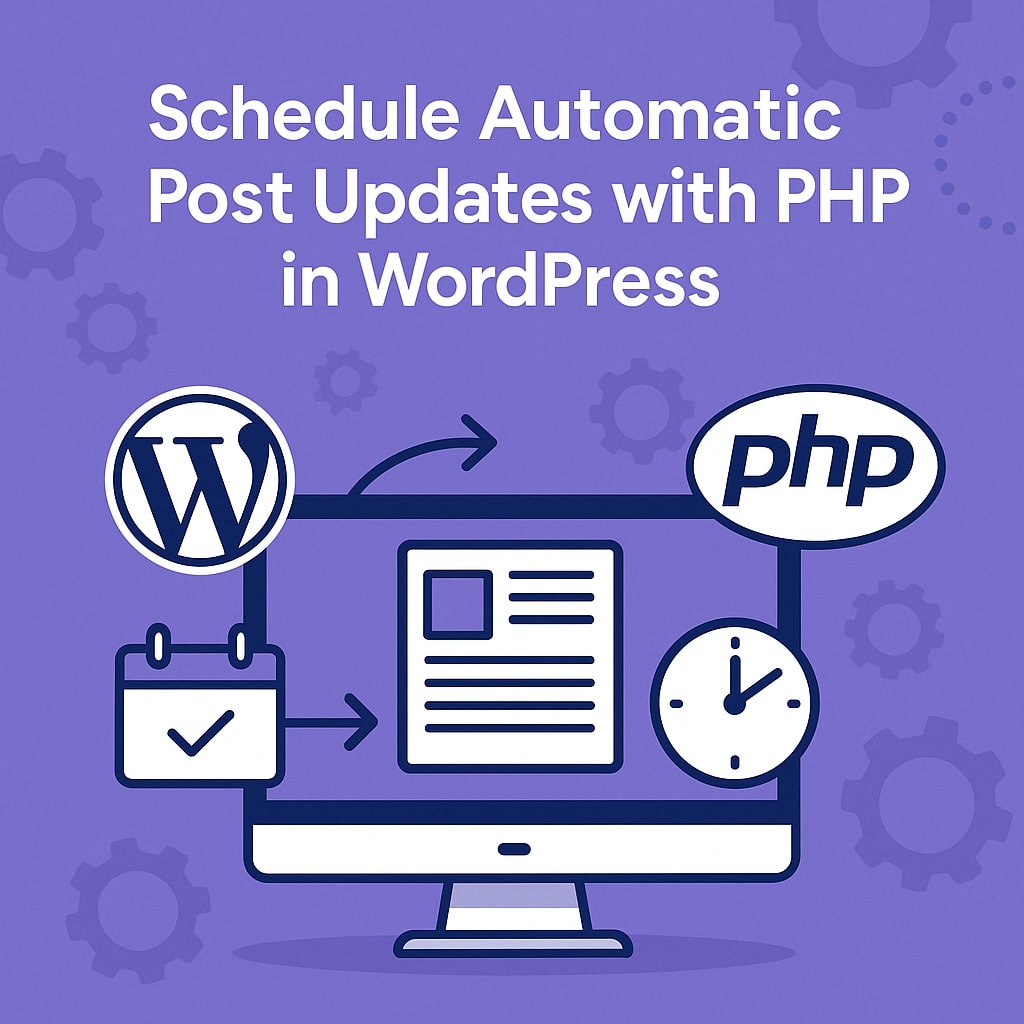Schedule Automatic Post Updates with PHP in WordPress: Keep Your Content Fresh
Keeping your website content up to date is one of the easiest ways to maintain relevance in search engines and attract returning visitors. But manually refreshing old posts can quickly become time-consuming — especially for large blogs.
In this tutorial, you’ll learn how to automate the process using PHP and WordPress’s built-in cron system. With just a few lines of code, you can automatically republish or update older posts on a schedule, giving your content a steady freshness boost without lifting a finger.
Understanding How WordPress Cron Works
Before we start coding, it’s important to understand what the WordPress Cron system actually does. Unlike a traditional server cron job that runs at precise intervals, WP-Cron is triggered by user visits. This means that your scheduled tasks only run when someone loads your website — a lightweight and flexible solution for most blogs.
You can use WP-Cron to perform almost any background task, from sending emails to regenerating thumbnails or updating posts automatically. However, for low-traffic sites, it’s recommended to use a real system cron on your server to ensure reliability.
Setting Up the Scheduled Task with PHP
Now let’s create the actual automation. WordPress provides a simple function called wp_schedule_event() that allows you to register a recurring task. First, you’ll check whether your event is already scheduled using wp_next_scheduled(), and if not, you’ll register it to run daily.
Once scheduled, the event will trigger a custom function — for example, one that searches for posts older than a year and updates their publication date. This combination of wp_schedule_event() and add_action() is the backbone of any automated process in WordPress.
Example snippet:
if ( ! wp_next_scheduled('auto_refresh_hook') ) {
wp_schedule_event(time(), 'daily', 'auto_refresh_hook');
}
add_action('auto_refresh_hook', 'refresh_old_posts');
function refresh_old_posts() {
// your post update logic here
}
Building the Post Update Function
With your cron event set up, it’s time to define what it will do. The goal is simple: find posts older than a certain number of days and refresh them automatically. You can use the get_posts() function to query for old posts, then wp_update_post() to modify their post_date or post_modified values.
This lightweight approach ensures your older evergreen content periodically appears fresh, moving back up in lists that sort by date. It’s a simple yet powerful SEO boost that requires almost no maintenance.
Example snippet:
function refresh_old_posts() {
$args = [
'post_type' => 'post',
'post_status' => 'publish',
'date_query' => [['before' => '1 year ago']],
'posts_per_page' => 5,
];
$posts = get_posts($args);
foreach ($posts as $post) {
wp_update_post([
'ID' => $post->ID,
'post_date' => current_time('mysql'),
'post_date_gmt' => gmdate('Y-m-d H:i:s'),
]);
}
}
Adding Safety and Optimization
When automating any background process, safety checks are essential. You don’t want multiple cron jobs running at the same time or updating too many posts at once. Add a transient lock to prevent overlaps and limit how many posts are updated per run (for example, 3–5).
You can also log the time of the last successful run to the database using update_option(). This helps you monitor the process or trigger a manual check later. For local testing, you can temporarily reduce the interval to run every few minutes — just remember to revert it to daily once everything works smoothly.
Example snippet:
function refresh_old_posts() {
if (get_transient('refresh_lock')) return; // prevent overlap
set_transient('refresh_lock', 1, 10 * MINUTE_IN_SECONDS);
$args = [
'post_type' => 'post',
'post_status' => 'publish',
'date_query' => [['before' => '1 year ago']],
'posts_per_page' => 3,
];
$posts = get_posts($args);
foreach ($posts as $post) {
wp_update_post(['ID' => $post->ID, 'post_date' => current_time('mysql')]);
}
update_option('last_refresh_run', current_time('mysql'));
delete_transient('refresh_lock');
}
Testing and Troubleshooting Your Cron Job
Once your automation is in place, it’s important to verify that it runs correctly. You can test it manually using WP-CLI commands like wp cron event list or wp cron event run auto_refresh_hook. For websites with little traffic, the cron might not trigger often — in that case, set up a real server cron to ping wp-cron.php every hour.
If your posts aren’t updating, double-check your function name, the hook connection (add_action()), and your date query parameters. You can also temporarily add error_log() inside the function to see whether it’s being executed.
When everything works as expected, revert your interval to daily and monitor the results in your post list or analytics — you should see older content steadily appearing closer to the top.
SEO and Content Strategy Benefits
Automatically refreshing older posts is more than just a technical trick — it’s a simple content marketing strategy. Search engines tend to reward freshness: updated content signals that a page is still relevant. Republishing or updating your evergreen articles helps them regain visibility in SERPs and keeps them circulating among your audience.
However, avoid using automation to fake freshness. Instead, use this cron system to support real updates — such as adding new statistics, internal links, or visuals. That way, your refreshed posts provide genuine value while also benefiting from the SEO boost that comes with an updated publication date.
For best results, pair automated date refreshes with a periodic editorial review: each time an article is republished, skim through it, update outdated information, and re-promote it across your channels.
Micro tools for SEO based on AI
Smart SEO Keyword Clustering & Intent Analysis Assistant Keyword Navigator is a specialized Gemini Gem…
Pet Projects: From Passion to Profit
What is a Pet Project?Why Are Pet Projects Popular?Understanding Pet ProjectsTypes of Pet ProjectsReal-World Examples…
Digital PR in the Modern Age: A Complete Guide
Establishing a strong online presence is crucial for any business or brand. This is where…
10 Steps For How To Become A Content Creator
Content creation has become one of the most sought-after careers today. As a content creator,…
Link Building for Crypto/Blockchain Websites
Link building plays a vital role in the SEO strategy of any crypto project. It…
Link Building for eCommerce Websites
SEO implementation for e-commerce is essential for driving business growth, as a large share of…
Conclusion: Set It, Forget It, and Keep Your Blog Alive
With just a few lines of PHP, you can automate one of the most repetitive tasks in content management — keeping your posts fresh. The WordPress Cron system allows you to quietly republish older articles, boost SEO signals, and maintain an active content schedule even when you’re not updating manually.
This small automation works best when paired with thoughtful editing and real improvements to your posts. It doesn’t replace creativity — it supports it. Set up your script once, monitor its performance, and let your evergreen content continue to work for you day after day.
Want to take it further? Combine this cron method with automated internal linking or keyword tracking scripts for a complete SEO automation toolkit.







